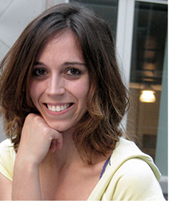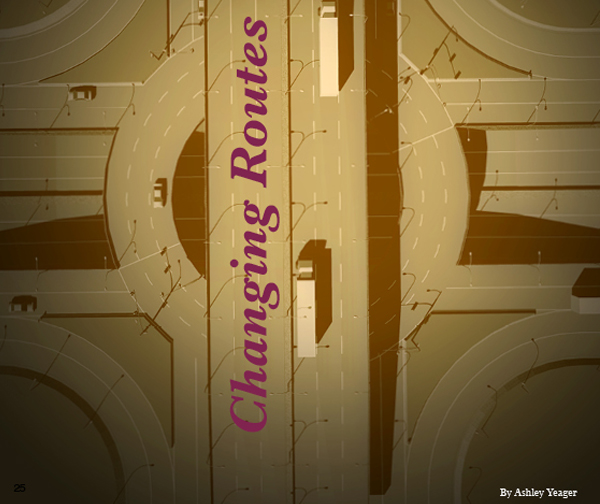Every time Georgia-Evangelia Katsargyri drives down Massachusetts Avenue in Cambridge, she thinks about the choices she is making and how changing her habits could help her get a few more miles to the gallon from her roommate's car. Her mind didn't always wander down this route on her drives, but since she began working at LIDS, she can't stop thinking about fuel economy and traffic flow.
Georgia-Evangelia, who jokes that "if you want to choose a more energy efficient way of calling me, you can use my nickname, Yola", grew up in Greece. As a kid, Yola had little interest in cars or fuel economy. She was fascinated with math. Her father, a mathematician himself, constantly shared his joy for the subject with her, challenging her with "mathematical problems cleverly disguised as games," she says. "I grew up with that way of thinking. It became intuitive, a way of seeing the world."
Yola has carried this way of seeing the world into her career choices. As an undergraduate she studied to become an electrical engineer, earning her degree from the National Technical University of Athens in 2006. The summer before she graduated, trying to enrich her knowledge and research experience, Yola came to the U.S. to explore a different academic environment. She visited the California Institute of Technology, where she participated in the SURF (Summer Undergraduate Research Fellowship) program and worked on part of her thesis for her diploma. The trip convinced her to make a more permanent move to the states to pursue her passion for engineering.
Seeing the dream come true, Yola was accepted at MIT and, upon arriving, was awarded the Paris C. Kanellakis Fellowship, which provided her with an opportunity to redirect her career path. Having focused on electromagnetics as an undergraduate, Yola decided to turn towards the fields of control and optimization. The fellowship, given through MIT's Electrical Engineering and Computer Science department, was a way to explore several labs and areas of electrical engineering, and it, along with the flexibility of MIT's academic culture, gave her the freedom to forgo choosing a research area and an advisor as soon as she came to the university. Instead, she was able to explore many options, meeting with professors and talking with other students to find the project and place she was most excited to be part of as she began her work at MIT.
During this exploration process and within the first few days of arriving, LIDS professor Munther Dahleh contacted her with an email she still remembers: "If you have a chance, please stop by my office so we can chat about finding you a research home." Munther gave Yola an office and started talking with her about his projects. "I was a bit scared my first days at MIT. But Munther and his students made me feel very welcomed. Munther is a person that makes you feel comfortable from the very first moment, " Yola says. Meeting LIDS students was also a pleasant surprise for her, as she realized that not only were they doing interesting work, but that they were a group with many interests outside of their research, too – an important balance.
Because of the way she was integrated into the team, she had no reservations about joining Munther's group. From among the many research directions he suggested to her, Yola chose to work on how to optimally control Hybrid Electric Vehicles (HEVs) for increased fuel efficiency. This project was based on a collaboration between Munther's research group and Ford Motor Company, a combination of working in academia and industry that greatly appealed to Yola. She was also intrigued by the idea of continuing her education by using theoretical tools on an application-oriented project.
HEVs have two power sources: an internal combustion engine, which consumes fuel, and a battery, which can store or provide energy to and from the powertrain unit, the group of components that deliver power to the road's surface. The vehicle can engage these power sources individually or at the same time. "For most HEVs that are currently on the market, how much each of the two power sources is used depends on the current conditions the car is experiencing, such as the vehicle speed and the torque demand of the moment," Yola says.
"Our idea was to take into account what was coming up next on the road," she adds, explaining that if a driver chooses an exact route using a GPS system, it is possible to know many of the characteristics the car will experience during that route, such as the number of traffic lights and stop signs, speed limit information or slope of the road. "For example, if we know that the car is about to travel downhill we can use the energy currently stored in the battery, because we know that we will replace that energy soon through regenerative braking at the bottom of the hill. This way we can save fuel by using the battery instead of or in addition to the internal combustion engine," Yola says. Munther's idea was to program the car to anticipate the features of a route and automatically predetermine the usage of gas and electric power sources to optimize both the fuel consumption and the life of the battery.
Working closely with Ford Motor Company, Munther, Yola, and Michael Rinehart, (another student in Munther's group), developed a system that meshed the features of the road with the information from the GPS and mapping systems, analyzed the prospective driving route, and established the most fuel-efficient pattern of utilizing gas or electric power. To test and evaluate the algorithm that they developed, Yola repeatedly drove the same route through Boston and Cambridge, tracking the speed limits, average driving speeds, traffic lights, stop signs, up-hills, down-hills and any other features that she could factor into how a vehicle traveled on the road. The vehicle she used, owned by her roommate, was a conventional HEV – without path forecasting – and she used the fuel efficiency of that car as a reference to quantify the benefits of her algorithm. The results showed that this "path forecasting" method, which optimized a hybrid's engine use, improved the vehicles' fuel economy by 10-12 percent. This was an exciting result, exceeding the expectations of the project and showing promise of an economically and environmentally friendly solution that could have mass-market appeal. Two US patent applications based on Yola's research were submitted by the Ford-MIT Alliance in 2011, and in a 2010 press release, Ford Motor Company stated that it is further developing these HEV technologies.
Since the end of the HEV project, Yola has been working with LIDS professor Emilio Frazzoli on the Singapore-MIT Alliance for Research and Technology (SMART) program, a research enterprise established by MIT and the National Research Foundation of Singapore to, in part, transform global transportation systems to meet current economic and environmental needs. Co-advised by both Munther and Emilio, Yola is currently working on the modeling and control of traffic in transportation networks.
Ever since she started working at LIDS, Yola's mind is always engaged by the job when she's driving. "Even now, every time I follow that Boston-Cambridge route, I still remember the exact distances between traffic lights! And every time I am in the car, I keep thinking of the most efficient way to drive, the most efficient route to choose and how Ford's hybrid, with our algorithm embedded in it, would work differently from my roommate's conventional hybrid," Yola says. That train of thought leads to an analysis of the drivers around her and of how their decisions lead to traffic and congestion, and then eventually to more metaphorical thoughts, specifically how working at LIDS has given Yola the ability to make her path. "What I like about both of my advisors is the great degree of freedom they give their students. They don't want to teach you to follow their route; they want to teach you how to create and follow your own," she says.




